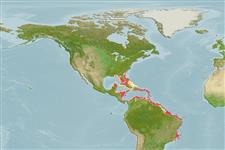Common names from other countries
Environment: milieu / climate zone / depth range / distribution range
Ecología
Asociado a arrecife; rango de profundidad 0 - 53 m (Ref. 101593). Tropical; 33°N - 24°S, 89°W - 32°W (Ref. 107482)
Distribución
Países | Áreas FAO | Ecosistemas | Ocurrencias, apariciones | Introducciones
Western Atlantic: Bermuda and Florida to Rio de Janeiro, Brazil, including Yucatan and the Caribbean Sea.
Length at first maturity / Tamaño / Peso / Age
Maturity: Lm ? range ? - ? cm Max length : 31.0 cm TL macho / no sexado; (Ref. 271); common length : 20.0 cm TL macho / no sexado; (Ref. 4)
West Central Atlantic; Southwest Atlantic: Western Atlantic; Bermuda and Florida to E. Brazil, including Yucatan and the Caribbean Sea. 31 cm, maximum total body length; 20 cm, common length. Occurs in coastal waters down to 50 m with rock or coral substrate (Ref. 4). Minimum depth range from Ref. 122059. Inhabits coastal waters with rock or coral substrates (Ref. 4). On rubble (Ref. 97531). Requires calcareous substrate with algae and gravel (Ref. 81730). Scarce and generally found in reef habitats (Ref. 104228). Coexists with Panulirus argus (Ref. 102863) but little competition is likely to occur between the two (Ref. 104228). In general, palinurids are mainly considered carnivores, usually feeding upon sluggish, easily captured animals where most material is eaten alive or freshly killed (Ref. 105260).
Life cycle and mating behavior
Madurez | Reproducción | Puesta | Huevos | Fecundidad | Larva
Members of the order Decapoda are mostly gonochoric. Mating behavior: Precopulatory courtship ritual is common (through olfactory and tactile cues); usually indirect sperm transfer.
Holthuis, L.B. 1991. (Ref. 4)
IUCN Red List Status (Ref. 130435)
CITES status (Ref. 108899)
Not Evaluated
Not Evaluated
Human uses
Pesquerías: comercial
| FishSource |
Herramientas
Más información
Age/SizeCrecimientoLength-weightLength-lengthMorfologíaLarvaAbundancia
Fuentes de Internet
Estimates based on models
Preferred temperature
(Ref.
115969): 25.4 - 28.1, mean 27.4 (based on 136 cells).
Vulnerability
Low vulnerability (21 of 100).
